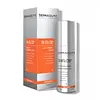What's inside
What's inside
 Key Ingredients
Key Ingredients

 Benefits
Benefits

 Concerns
Concerns

 Ingredients Side-by-side
Ingredients Side-by-side

Propylene Glycol
HumectantWater
Skin ConditioningAscorbic Acid
AntioxidantAscorbyl Methylsilanol Pectinate
AntioxidantAlcohol Denat.
AntimicrobialCyclopentasiloxane
EmollientMethylpropanediol
SolventPvp
Emulsion StabilisingDimethicone
EmollientAscorbyl Tetraisopalmitate
AntioxidantTocopheryl Acetate
AntioxidantEthyl Ferulate
AntioxidantTocopherol
AntioxidantFerulic Acid
AntimicrobialAscorbyl Palmitate
AntioxidantSphingolipids
EmollientPhospholipids
Skin ConditioningSodium PCA
HumectantMagnesium PCA
HumectantZinc PCA
HumectantManganese PCA
HumectantDimethicone Crosspolymer
Emulsion StabilisingXanthan Gum
EmulsifyingAminomethyl Propanol
BufferingCamphor
MaskingPotassium Sorbate
PreservativeSodium Citrate
BufferingLecithin
EmollientHydrogenated Palm Glycerides Citrate
EmollientEthylhexylglycerin
Skin ConditioningPentylene Glycol
Skin ConditioningPhenoxyethanol
PreservativeDisodium EDTA
Propylene Glycol, Water, Ascorbic Acid, Ascorbyl Methylsilanol Pectinate, Alcohol Denat., Cyclopentasiloxane, Methylpropanediol, Pvp, Dimethicone, Ascorbyl Tetraisopalmitate, Tocopheryl Acetate, Ethyl Ferulate, Tocopherol, Ferulic Acid, Ascorbyl Palmitate, Sphingolipids, Phospholipids, Sodium PCA, Magnesium PCA, Zinc PCA, Manganese PCA, Dimethicone Crosspolymer, Xanthan Gum, Aminomethyl Propanol, Camphor, Potassium Sorbate, Sodium Citrate, Lecithin, Hydrogenated Palm Glycerides Citrate, Ethylhexylglycerin, Pentylene Glycol, Phenoxyethanol, Disodium EDTA
Water
Skin Conditioning3-O-Ethyl Ascorbic Acid
Skin ConditioningPropylene Glycol
HumectantAlcohol Denat.
AntimicrobialGlycerin
HumectantPropanediol
SolventEthoxydiglycol
HumectantPentylene Glycol
Skin ConditioningDiglycerin
HumectantXylitylglucoside
HumectantAlgin
MaskingDisodium Phosphate
BufferingEvodia Rutaecarpa Fruit Extract
Skin ConditioningGlyceryl Polyacrylate
Methyl Diisopropyl Propionamide
MaskingPotassium Phosphate
BufferingPullulan
Serine
MaskingTrehalose
HumectantAnhydroxylitol
HumectantSodium Hyaluronate
HumectantUrea
BufferingXylitol
Humectant1,2-Hexanediol
Skin ConditioningCaprylyl Glycol
EmollientCitric Acid
BufferingHydroxyethylcellulose
Emulsion StabilisingSodium Citrate
BufferingParfum
MaskingWater, 3-O-Ethyl Ascorbic Acid, Propylene Glycol, Alcohol Denat., Glycerin, Propanediol, Ethoxydiglycol, Pentylene Glycol, Diglycerin, Xylitylglucoside, Algin, Disodium Phosphate, Evodia Rutaecarpa Fruit Extract, Glyceryl Polyacrylate, Methyl Diisopropyl Propionamide, Potassium Phosphate, Pullulan, Serine, Trehalose, Anhydroxylitol, Sodium Hyaluronate, Urea, Xylitol, 1,2-Hexanediol, Caprylyl Glycol, Citric Acid, Hydroxyethylcellulose, Sodium Citrate, Parfum
Ingredients Explained
These ingredients are found in both products.
Ingredients higher up in an ingredient list are typically present in a larger amount.
Alcohol Denat. is an alcohol with a denaturant property. It is created by mixing ethanol with other additives.
This ingredient gets a bad rep because it is irritating and drying - mostly due to its astringent property. Astringents draw out natural oils in tissue, constricting pores and leaving your skin dried out.
However, alcohol denat. is not all that bad.
Due to its low molecular weight, alcohol denat. tends to evaporate quickly. One study on pig skin found half of applied alcohol evaporated in 10 seconds and less than 3% stayed on skin.
This also helps other ingredients become better absorbed upon application.
Studies are conflicted about whether this ingredient causes skin dehydration. One study from 2005 found adding emollients to propanol-based sanitizer decreased skin dryness and irritation. Another study found irritation only occurs if your skin is already damaged.
Small amounts of alcohol are generally tolerated by oily skin or people who live in humid environments.
The rule of thumb is if this alcohol is near the end of an ingredients list, it will probably not affect your skin much.
Also...
This ingredient has antimicrobial and solvent properties.
The antimicrobial property helps preserve products and increase their shelf life. As a solvent, it helps dissolve other ingredients.
Other types of astringent alcohols include:
Learn more about Alcohol Denat.Pentylene glycol is typically used within a product to thicken it. It also adds a smooth, soft, and moisturizing feel to the product. It is naturally found in plants such as sugar beets.
The hydrophilic trait of Pentylene Glycol makes it a humectant. As a humectant, Pentylene Glycol helps draw moisture from the air to your skin. This can help keep your skin hydrated.
This property also makes Pentylene Glycol a great texture enhancer. It can also help thicken or stabilize a product.
Pentylene Glycol also acts as a mild preservative and helps to keep a product microbe-free.
Some people may experience mild eye and skin irritation from Pentylene Glycol. We always recommend speaking with a professional about using this ingredient in your routine.
Pentylene Glycol has a low molecular weight and is part of the 1,2-glycol family.
Learn more about Pentylene GlycolPropylene Glycol is an odorless, colorless liquid. As a humectant, it helps skin retain moisture. It also aids in delivering active ingredients.
Another role of this ingredient is preventing a product from melting or freezing. Propylene glycol also adds antimicrobrial properties to a product, elongating product lifespan.
This ingredient is considered an organic alcohol and commonly added into both cosmetics and foods.
Those with sensitive skin or conditions may develop a rash when using this ingredient.
Learn more about Propylene GlycolSodium Citrate is the sodium salts of citric acid. In skincare, it is used to alter pH levels and acts as a preservative.
Its main functions are to maintain the pH of a product and neutralize metal ions.
The acidity of our skin is maintained by our glands and skin biome; normal pH level of skin is slightly acidic (~4.75-5.5).
Being slightly acidic allows our skin to create an "acid mantle". This acid mantle is a thin barrier that protects our skin from bacteria and contaminants.
Learn more about Sodium CitrateWater. It's the most common cosmetic ingredient of all. You'll usually see it at the top of ingredient lists, meaning that it makes up the largest part of the product.
So why is it so popular? Water most often acts as a solvent - this means that it helps dissolve other ingredients into the formulation.
You'll also recognize water as that liquid we all need to stay alive. If you see this, drink a glass of water. Stay hydrated!
Learn more about Water